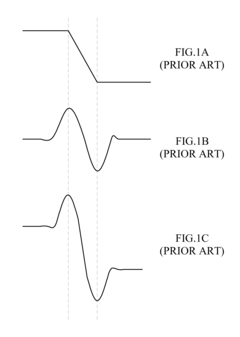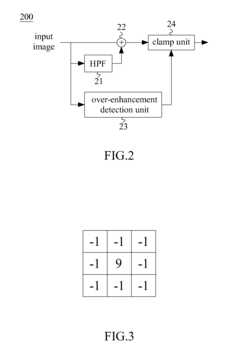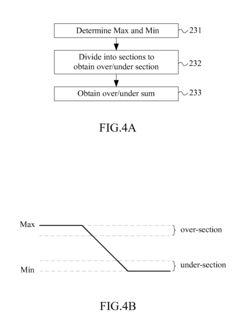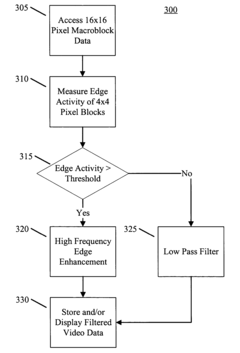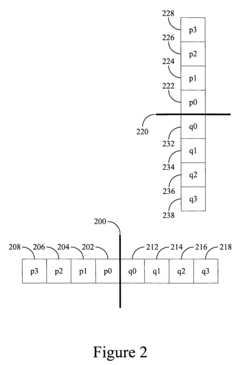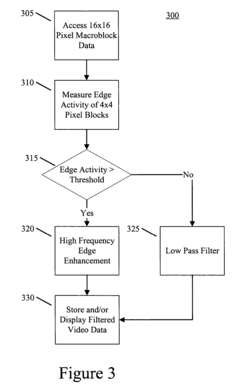Utilizing High Pass Filters for Improved Image Enhancement in Photography
JUL 28, 20259 MIN READ
Generate Your Research Report Instantly with AI Agent
Patsnap Eureka helps you evaluate technical feasibility & market potential.
High Pass Filter Background and Objectives
High pass filters have been a fundamental tool in image processing and photography since the early days of digital imaging. Originating from signal processing theory, these filters were adapted for use in image enhancement to accentuate fine details and edges within photographs. The evolution of high pass filtering techniques has closely followed advancements in digital image processing technology, with significant milestones occurring in the late 20th and early 21st centuries.
The primary objective of utilizing high pass filters in photography is to improve image quality by enhancing sharpness, clarity, and overall detail. This is achieved by isolating and amplifying high-frequency components of an image, which typically correspond to edges and fine textures. As digital cameras and image editing software have become more sophisticated, the application of high pass filters has expanded beyond simple sharpening to include more complex image enhancement techniques.
In recent years, the integration of high pass filtering into advanced image processing algorithms has led to the development of more nuanced and effective enhancement methods. These include adaptive high pass filtering, which adjusts filter parameters based on local image characteristics, and frequency-domain high pass filtering, which offers greater precision in isolating specific frequency ranges for enhancement.
The ongoing technological trend in this field is moving towards more intelligent and automated high pass filtering systems. Machine learning and artificial intelligence are being leveraged to optimize filter parameters and application methods, resulting in more natural-looking enhancements that preserve image integrity while significantly improving detail and clarity.
As we look to the future, the objectives for high pass filtering in photography continue to evolve. There is a growing focus on developing real-time high pass filtering techniques for live image processing in cameras and mobile devices. Additionally, researchers are exploring ways to combine high pass filtering with other image enhancement methods to create more comprehensive and effective image improvement solutions.
The ultimate goal in this field is to achieve a perfect balance between detail enhancement and natural image appearance, allowing photographers and image editors to push the boundaries of image quality while maintaining authenticity. This involves not only improving the technical aspects of high pass filtering but also understanding and adapting to the perceptual preferences of viewers in different photographic contexts.
The primary objective of utilizing high pass filters in photography is to improve image quality by enhancing sharpness, clarity, and overall detail. This is achieved by isolating and amplifying high-frequency components of an image, which typically correspond to edges and fine textures. As digital cameras and image editing software have become more sophisticated, the application of high pass filters has expanded beyond simple sharpening to include more complex image enhancement techniques.
In recent years, the integration of high pass filtering into advanced image processing algorithms has led to the development of more nuanced and effective enhancement methods. These include adaptive high pass filtering, which adjusts filter parameters based on local image characteristics, and frequency-domain high pass filtering, which offers greater precision in isolating specific frequency ranges for enhancement.
The ongoing technological trend in this field is moving towards more intelligent and automated high pass filtering systems. Machine learning and artificial intelligence are being leveraged to optimize filter parameters and application methods, resulting in more natural-looking enhancements that preserve image integrity while significantly improving detail and clarity.
As we look to the future, the objectives for high pass filtering in photography continue to evolve. There is a growing focus on developing real-time high pass filtering techniques for live image processing in cameras and mobile devices. Additionally, researchers are exploring ways to combine high pass filtering with other image enhancement methods to create more comprehensive and effective image improvement solutions.
The ultimate goal in this field is to achieve a perfect balance between detail enhancement and natural image appearance, allowing photographers and image editors to push the boundaries of image quality while maintaining authenticity. This involves not only improving the technical aspects of high pass filtering but also understanding and adapting to the perceptual preferences of viewers in different photographic contexts.
Market Demand Analysis for Image Enhancement
The market demand for image enhancement technologies in photography has been steadily growing, driven by the increasing popularity of digital photography and the rising expectations for high-quality images. High pass filters, as a key component in image enhancement techniques, have gained significant attention in both consumer and professional markets.
In the consumer segment, the proliferation of smartphones with advanced camera capabilities has created a massive user base seeking to improve their photo quality. Social media platforms and photo-sharing apps have further fueled this demand, as users strive to create visually appealing content. The integration of AI-powered image enhancement features in mobile devices has set new standards for image quality, making high pass filter technology increasingly relevant.
Professional photographers and content creators represent another crucial market segment. These users require advanced tools to achieve optimal image sharpness, detail, and overall quality. The demand for high-end cameras, lenses, and post-processing software incorporating sophisticated image enhancement algorithms continues to grow. This trend is particularly evident in industries such as advertising, fashion, and product photography, where image quality directly impacts business outcomes.
The film and television industry also contributes significantly to the market demand for image enhancement technologies. With the shift towards higher resolution formats like 4K and 8K, there is an increased need for advanced image processing techniques to maintain clarity and detail. High pass filters play a crucial role in this context, helping to preserve fine details and enhance overall image quality.
In the field of medical imaging, there is a growing demand for improved image enhancement techniques. High pass filters are essential in applications such as X-ray imaging, MRI, and CT scans, where clear and detailed images are critical for accurate diagnosis. The healthcare sector's continuous technological advancements drive the need for more sophisticated image processing solutions.
The surveillance and security industry represents another significant market for image enhancement technologies. As the quality of security cameras improves, there is an increasing demand for advanced image processing techniques to enhance video footage, particularly in low-light conditions or when dealing with long-range captures.
Looking at market projections, the global image processing software market, which includes image enhancement technologies, is expected to experience substantial growth. This growth is attributed to factors such as increasing adoption of cloud-based image processing solutions, rising demand for high-quality images across various industries, and advancements in AI and machine learning technologies applied to image processing.
In the consumer segment, the proliferation of smartphones with advanced camera capabilities has created a massive user base seeking to improve their photo quality. Social media platforms and photo-sharing apps have further fueled this demand, as users strive to create visually appealing content. The integration of AI-powered image enhancement features in mobile devices has set new standards for image quality, making high pass filter technology increasingly relevant.
Professional photographers and content creators represent another crucial market segment. These users require advanced tools to achieve optimal image sharpness, detail, and overall quality. The demand for high-end cameras, lenses, and post-processing software incorporating sophisticated image enhancement algorithms continues to grow. This trend is particularly evident in industries such as advertising, fashion, and product photography, where image quality directly impacts business outcomes.
The film and television industry also contributes significantly to the market demand for image enhancement technologies. With the shift towards higher resolution formats like 4K and 8K, there is an increased need for advanced image processing techniques to maintain clarity and detail. High pass filters play a crucial role in this context, helping to preserve fine details and enhance overall image quality.
In the field of medical imaging, there is a growing demand for improved image enhancement techniques. High pass filters are essential in applications such as X-ray imaging, MRI, and CT scans, where clear and detailed images are critical for accurate diagnosis. The healthcare sector's continuous technological advancements drive the need for more sophisticated image processing solutions.
The surveillance and security industry represents another significant market for image enhancement technologies. As the quality of security cameras improves, there is an increasing demand for advanced image processing techniques to enhance video footage, particularly in low-light conditions or when dealing with long-range captures.
Looking at market projections, the global image processing software market, which includes image enhancement technologies, is expected to experience substantial growth. This growth is attributed to factors such as increasing adoption of cloud-based image processing solutions, rising demand for high-quality images across various industries, and advancements in AI and machine learning technologies applied to image processing.
Current Challenges in Image Enhancement Techniques
Image enhancement techniques have made significant strides in recent years, yet several challenges persist in achieving optimal results. One of the primary obstacles is the preservation of fine details while reducing noise. As high-pass filters are employed to sharpen images, they often amplify noise simultaneously, leading to a trade-off between detail enhancement and noise reduction.
Another significant challenge lies in the adaptive application of enhancement techniques across diverse image content. Different regions within an image may require varying levels of enhancement, and current algorithms struggle to automatically adjust parameters based on local image characteristics. This limitation often results in over-sharpening of some areas while under-enhancing others, leading to inconsistent image quality.
The computational complexity of advanced image enhancement algorithms poses a challenge for real-time processing, especially in mobile devices or cameras with limited processing power. This constraint often forces a compromise between enhancement quality and processing speed, limiting the practical application of sophisticated techniques in consumer-grade devices.
Color fidelity is another area of concern in image enhancement. High-pass filters, while effective in sharpening edges, can sometimes introduce color artifacts or alter the original color balance of the image. Maintaining accurate color reproduction while enhancing image details remains a delicate balancing act.
The subjective nature of image quality assessment further complicates the enhancement process. What constitutes an "improved" image can vary significantly based on viewer preferences, cultural backgrounds, and intended applications. Developing universal metrics for quantifying enhancement quality that align with human perception is an ongoing challenge.
Edge preservation in high-contrast areas presents another hurdle. Current techniques often struggle to enhance edges without creating halos or ringing artifacts, particularly in scenes with sharp transitions between light and dark regions. This issue is especially pronounced in high dynamic range (HDR) imaging scenarios.
Lastly, the integration of machine learning and AI into image enhancement pipelines, while promising, introduces new challenges. These include the need for extensive training data, potential biases in enhancement results, and the difficulty in explaining or fine-tuning AI-driven enhancements for specific use cases.
Addressing these challenges requires interdisciplinary approaches, combining advances in signal processing, computer vision, and machine learning. As research progresses, overcoming these obstacles will pave the way for more sophisticated, adaptive, and perceptually aligned image enhancement techniques.
Another significant challenge lies in the adaptive application of enhancement techniques across diverse image content. Different regions within an image may require varying levels of enhancement, and current algorithms struggle to automatically adjust parameters based on local image characteristics. This limitation often results in over-sharpening of some areas while under-enhancing others, leading to inconsistent image quality.
The computational complexity of advanced image enhancement algorithms poses a challenge for real-time processing, especially in mobile devices or cameras with limited processing power. This constraint often forces a compromise between enhancement quality and processing speed, limiting the practical application of sophisticated techniques in consumer-grade devices.
Color fidelity is another area of concern in image enhancement. High-pass filters, while effective in sharpening edges, can sometimes introduce color artifacts or alter the original color balance of the image. Maintaining accurate color reproduction while enhancing image details remains a delicate balancing act.
The subjective nature of image quality assessment further complicates the enhancement process. What constitutes an "improved" image can vary significantly based on viewer preferences, cultural backgrounds, and intended applications. Developing universal metrics for quantifying enhancement quality that align with human perception is an ongoing challenge.
Edge preservation in high-contrast areas presents another hurdle. Current techniques often struggle to enhance edges without creating halos or ringing artifacts, particularly in scenes with sharp transitions between light and dark regions. This issue is especially pronounced in high dynamic range (HDR) imaging scenarios.
Lastly, the integration of machine learning and AI into image enhancement pipelines, while promising, introduces new challenges. These include the need for extensive training data, potential biases in enhancement results, and the difficulty in explaining or fine-tuning AI-driven enhancements for specific use cases.
Addressing these challenges requires interdisciplinary approaches, combining advances in signal processing, computer vision, and machine learning. As research progresses, overcoming these obstacles will pave the way for more sophisticated, adaptive, and perceptually aligned image enhancement techniques.
Existing High Pass Filter Solutions
01 High-pass filtering for edge enhancement
High-pass filters are used to enhance image edges and fine details by emphasizing high-frequency components. This technique improves image sharpness and contrast, making edges more pronounced and visible. The process involves convolving the image with a high-pass filter kernel, which suppresses low-frequency information while amplifying high-frequency content.- High-pass filtering for edge enhancement: High-pass filters are used to enhance image edges and fine details by emphasizing high-frequency components. This technique improves image sharpness and contrast, making edges more pronounced and visible. The process involves convolving the image with a high-pass filter kernel, which suppresses low-frequency information while amplifying high-frequency content.
- Adaptive high-pass filtering techniques: Adaptive high-pass filtering methods adjust filter parameters based on local image characteristics. These techniques analyze image content to determine optimal filter strengths and thresholds, allowing for more effective enhancement of different image regions. Adaptive approaches can better preserve important details while reducing artifacts in smooth areas.
- Combination of high-pass filtering with other enhancement methods: High-pass filtering is often combined with other image enhancement techniques to achieve better results. This may include integrating high-pass filters with low-pass filters, noise reduction algorithms, or contrast enhancement methods. The combination of multiple techniques can lead to more balanced and visually appealing image enhancements.
- Hardware implementation of high-pass filters: Specialized hardware designs and circuits are developed to implement high-pass filters for real-time image enhancement. These hardware solutions can include dedicated image processing chips, FPGAs, or custom integrated circuits. Hardware implementations offer faster processing speeds and lower power consumption compared to software-based solutions.
- High-pass filtering in specific imaging applications: High-pass filtering techniques are applied in various specialized imaging applications, such as medical imaging, satellite imagery, and industrial inspection. These applications may require custom filter designs or parameters to address specific enhancement needs, such as highlighting particular features or compensating for imaging system limitations.
02 Adaptive high-pass filtering techniques
Adaptive high-pass filtering methods adjust filter parameters based on local image characteristics. These techniques analyze image content to determine optimal filter strengths and thresholds, allowing for more effective enhancement of different image regions. Adaptive approaches can better preserve important details while reducing artifacts in smooth areas.Expand Specific Solutions03 Combination of high-pass filtering with other enhancement methods
High-pass filtering is often combined with other image enhancement techniques to achieve better results. This may include integrating high-pass filters with low-pass filters, noise reduction algorithms, or contrast enhancement methods. The combination of multiple techniques can lead to more balanced and visually appealing image enhancements.Expand Specific Solutions04 Hardware implementation of high-pass filters
Specialized hardware designs and circuits are developed to implement high-pass filters for real-time image enhancement. These hardware solutions can include dedicated image processing chips, FPGAs, or custom integrated circuits. Hardware implementations offer faster processing speeds and lower power consumption compared to software-based approaches.Expand Specific Solutions05 High-pass filtering in specific imaging applications
High-pass filtering techniques are applied in various specialized imaging applications, such as medical imaging, satellite imagery, and surveillance systems. These applications may require custom filter designs or parameters to address specific enhancement needs, such as improving the visibility of certain anatomical structures in medical images or enhancing terrain features in satellite imagery.Expand Specific Solutions
Key Players in Image Processing Software
The high pass filter technology for image enhancement in photography is in a mature stage of development, with a substantial market size driven by the widespread adoption of digital imaging across various sectors. The competitive landscape is dominated by established players like Sony, Nikon, and Canon, who have integrated advanced filtering techniques into their camera systems. These companies leverage their extensive R&D capabilities and patent portfolios to maintain a technological edge. Emerging players such as Huawei and Samsung are also making significant strides, particularly in smartphone camera technology, incorporating AI-driven image processing algorithms that include sophisticated high pass filtering. The market is characterized by continuous innovation, with companies focusing on improving real-time processing capabilities and enhancing filter customization options to meet diverse user needs.
Sony Group Corp.
Technical Solution: Sony has implemented a multi-stage high-pass filtering system in their Alpha series cameras and image sensors. Their approach begins at the sensor level with a unique pixel architecture that enhances high-frequency detail capture[2]. This is followed by their BIONZ X image processor, which employs advanced high-pass filtering algorithms. Sony's system uses a combination of spatial and frequency domain filtering techniques to enhance image sharpness while preserving natural textures[4]. They have also introduced AI-based high-pass filtering in their latest models, which can identify specific subjects and apply optimized filtering parameters for different elements within the frame, such as enhancing facial features in portraits or fine details in landscape shots[5].
Strengths: Comprehensive approach from sensor to processing, AI-enhanced filtering for subject-specific optimization. Weaknesses: Complex system may be more challenging to fine-tune for specific user preferences.
Nikon Corp.
Technical Solution: Nikon has developed an advanced high-pass filter system for their digital cameras, particularly in their professional DSLR and mirrorless lines. Their approach combines hardware and software solutions. On the hardware side, they use a specialized optical low-pass filter that allows for the passage of high-frequency information while reducing moiré and aliasing[1]. This is complemented by their EXPEED image processing engine, which incorporates adaptive high-pass filtering algorithms. These algorithms analyze the image content and apply varying degrees of sharpening based on the frequency content of different areas within the image[3]. This selective approach enhances fine details and textures without over-sharpening areas that don't require it, resulting in more natural-looking images with improved clarity.
Strengths: Balanced approach combining hardware and software solutions, adaptive filtering for optimal results across various scenes. Weaknesses: May require more processing power, potentially affecting battery life in portable devices.
Core Innovations in High Pass Filtering
Image enhancement system and method
PatentInactiveUS20140029866A1
Innovation
- An image enhancement system comprising a high-pass filter, an adder, and an over-enhancement detection unit, which generates a high-pass image and adds it to the input image while detecting and preventing overshoot or undershoot through a clamp unit or multiplier to maintain image quality.
Method and apparatus for image enhancement for low bit rate video compression
PatentActiveUS7430336B2
Innovation
- A high pass filter is used to emphasize high frequency edges in decoded images, enhancing them by overlaying the filtered output onto the image, which can be implemented using existing deblocking filter conditionals and circuitry in hardware platforms like Mobile Station Modem devices, effectively reducing blur and conserving edge information.
Computational Requirements and Performance
The implementation of high pass filters for image enhancement in photography requires careful consideration of computational requirements and performance factors. These filters, while effective in sharpening edges and enhancing details, can be computationally intensive, especially when applied to high-resolution images or in real-time processing scenarios.
The computational complexity of high pass filtering primarily depends on the filter size and the image dimensions. For a typical 3x3 or 5x5 kernel, the operation involves convolving the filter with each pixel in the image, resulting in a time complexity of O(n^2) for an n x n image. This can be particularly demanding for large images or when processing multiple frames in video applications.
Memory usage is another critical factor to consider. High pass filtering typically requires storing both the original image and the filtered result, potentially doubling the memory footprint. For high-resolution images, this can lead to significant memory consumption, especially on devices with limited resources.
To optimize performance, various techniques can be employed. One approach is to utilize parallel processing capabilities of modern CPUs and GPUs. By dividing the image into smaller blocks and processing them concurrently, significant speedups can be achieved. GPU acceleration, in particular, can dramatically reduce processing times due to its ability to handle multiple pixel operations simultaneously.
Another optimization strategy involves using separable filters, where a 2D high pass filter can be decomposed into two 1D filters applied sequentially. This approach can reduce the number of computations required, especially for larger kernel sizes.
For real-time applications, such as live video processing or camera preview modes, efficient implementation is crucial. Techniques like incremental filtering, where only the changed portions of an image are processed, can help maintain responsiveness. Additionally, adaptive filtering approaches that adjust the filter parameters based on image content can optimize both performance and visual quality.
The choice of programming language and libraries also impacts performance. Low-level languages like C++ or optimized libraries such as OpenCV can provide significant performance benefits compared to higher-level scripting languages. Hardware-specific optimizations, such as using SIMD (Single Instruction, Multiple Data) instructions on CPUs or leveraging specialized image processing hardware in mobile devices, can further enhance performance.
In conclusion, while high pass filters offer powerful image enhancement capabilities, their implementation must be carefully optimized to balance computational requirements with performance needs. By leveraging parallel processing, employing efficient algorithms, and utilizing hardware-specific optimizations, it is possible to achieve high-quality image enhancement with acceptable performance across a range of devices and applications.
The computational complexity of high pass filtering primarily depends on the filter size and the image dimensions. For a typical 3x3 or 5x5 kernel, the operation involves convolving the filter with each pixel in the image, resulting in a time complexity of O(n^2) for an n x n image. This can be particularly demanding for large images or when processing multiple frames in video applications.
Memory usage is another critical factor to consider. High pass filtering typically requires storing both the original image and the filtered result, potentially doubling the memory footprint. For high-resolution images, this can lead to significant memory consumption, especially on devices with limited resources.
To optimize performance, various techniques can be employed. One approach is to utilize parallel processing capabilities of modern CPUs and GPUs. By dividing the image into smaller blocks and processing them concurrently, significant speedups can be achieved. GPU acceleration, in particular, can dramatically reduce processing times due to its ability to handle multiple pixel operations simultaneously.
Another optimization strategy involves using separable filters, where a 2D high pass filter can be decomposed into two 1D filters applied sequentially. This approach can reduce the number of computations required, especially for larger kernel sizes.
For real-time applications, such as live video processing or camera preview modes, efficient implementation is crucial. Techniques like incremental filtering, where only the changed portions of an image are processed, can help maintain responsiveness. Additionally, adaptive filtering approaches that adjust the filter parameters based on image content can optimize both performance and visual quality.
The choice of programming language and libraries also impacts performance. Low-level languages like C++ or optimized libraries such as OpenCV can provide significant performance benefits compared to higher-level scripting languages. Hardware-specific optimizations, such as using SIMD (Single Instruction, Multiple Data) instructions on CPUs or leveraging specialized image processing hardware in mobile devices, can further enhance performance.
In conclusion, while high pass filters offer powerful image enhancement capabilities, their implementation must be carefully optimized to balance computational requirements with performance needs. By leveraging parallel processing, employing efficient algorithms, and utilizing hardware-specific optimizations, it is possible to achieve high-quality image enhancement with acceptable performance across a range of devices and applications.
User Interface Design for Filter Application
The user interface design for filter application in high pass filter-based image enhancement systems plays a crucial role in ensuring efficient and user-friendly operation. A well-designed interface should provide intuitive controls for adjusting filter parameters while offering real-time previews of the enhanced image.
The main components of an effective user interface for high pass filter application typically include a slider or dial for adjusting the filter strength, allowing users to fine-tune the level of enhancement. This control should be accompanied by clear visual feedback, such as a numerical value or graphical representation of the filter intensity.
Another essential element is a split-screen or side-by-side comparison view, enabling users to easily compare the original image with the filtered result. This feature helps users assess the impact of their adjustments and make informed decisions about the desired level of enhancement.
Preset options can significantly improve user experience by offering quick access to commonly used filter settings. These presets can be tailored to different photography genres or styles, such as landscape, portrait, or macro photography, allowing users to achieve desired results with minimal effort.
Advanced users may benefit from more granular control options, such as the ability to adjust the filter's frequency range or apply localized enhancements to specific areas of the image. These features can be tucked away in an advanced settings panel to avoid overwhelming novice users while still providing powerful tools for experienced photographers.
A histogram display can provide valuable information about the image's tonal distribution before and after filtering, helping users make more informed decisions about their adjustments. Additionally, a zoom function allows for detailed inspection of the filter's effects on specific image areas.
To enhance usability, the interface should incorporate undo/redo functionality and the ability to save custom presets. This allows users to experiment freely with different filter settings without fear of irreversible changes and to create personalized enhancement profiles for future use.
Consideration should also be given to the interface's responsiveness and performance. Real-time updates of the filtered preview as users adjust parameters are essential for a smooth and interactive experience. Optimizing the processing algorithms and leveraging hardware acceleration can help achieve this responsiveness, even when working with high-resolution images.
The main components of an effective user interface for high pass filter application typically include a slider or dial for adjusting the filter strength, allowing users to fine-tune the level of enhancement. This control should be accompanied by clear visual feedback, such as a numerical value or graphical representation of the filter intensity.
Another essential element is a split-screen or side-by-side comparison view, enabling users to easily compare the original image with the filtered result. This feature helps users assess the impact of their adjustments and make informed decisions about the desired level of enhancement.
Preset options can significantly improve user experience by offering quick access to commonly used filter settings. These presets can be tailored to different photography genres or styles, such as landscape, portrait, or macro photography, allowing users to achieve desired results with minimal effort.
Advanced users may benefit from more granular control options, such as the ability to adjust the filter's frequency range or apply localized enhancements to specific areas of the image. These features can be tucked away in an advanced settings panel to avoid overwhelming novice users while still providing powerful tools for experienced photographers.
A histogram display can provide valuable information about the image's tonal distribution before and after filtering, helping users make more informed decisions about their adjustments. Additionally, a zoom function allows for detailed inspection of the filter's effects on specific image areas.
To enhance usability, the interface should incorporate undo/redo functionality and the ability to save custom presets. This allows users to experiment freely with different filter settings without fear of irreversible changes and to create personalized enhancement profiles for future use.
Consideration should also be given to the interface's responsiveness and performance. Real-time updates of the filtered preview as users adjust parameters are essential for a smooth and interactive experience. Optimizing the processing algorithms and leveraging hardware acceleration can help achieve this responsiveness, even when working with high-resolution images.
Unlock deeper insights with Patsnap Eureka Quick Research — get a full tech report to explore trends and direct your research. Try now!
Generate Your Research Report Instantly with AI Agent
Supercharge your innovation with Patsnap Eureka AI Agent Platform!

